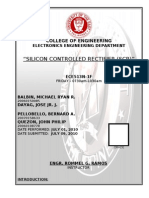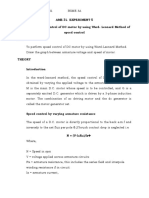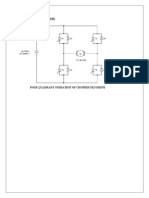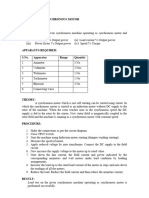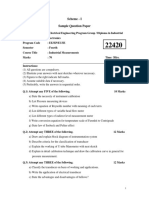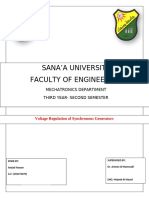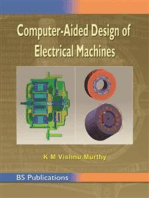Experiment 2 - Iduction Motor Drive Using Slip Power Recovery
Experiment 2 - Iduction Motor Drive Using Slip Power Recovery
Uploaded by
Deepak BansalCopyright:
Available Formats
Experiment 2 - Iduction Motor Drive Using Slip Power Recovery
Experiment 2 - Iduction Motor Drive Using Slip Power Recovery
Uploaded by
Deepak BansalOriginal Description:
Copyright
Available Formats
Share this document
Did you find this document useful?
Is this content inappropriate?
Copyright:
Available Formats
Experiment 2 - Iduction Motor Drive Using Slip Power Recovery
Experiment 2 - Iduction Motor Drive Using Slip Power Recovery
Uploaded by
Deepak BansalCopyright:
Available Formats
Experiment 2 Slip power recovery scheme for IM 1 F.
Rahman
ELEC4613 Electric Drive Systems August 2013
University of New South Wales
School of Electrical Engineering & Telecommunications
ELEC4613 - ELECTRIC DRIVE SYSTEMS
Experiment 2 IM drive with slip power recovery
1. Introduction
This experiment introduces the method of speed control of a slip-ring induction machine via
control of its slip power. This scheme, which is widely used in pumping installations, requires
only a low rated power converter to return some of the slip power in the rotor to the AC mains.
The experiment demonstrates the controllability of the method and the energy saving
opportunity that this method offers. A variant of this scheme is widely used wind power systems
employing induction generators.
2. Brief Theory
Slip power control (The Static Scherbius Scheme)
This static Scherbius scheme is indicated in figure 1. In this scheme, the rotor terminals of a slip-
ring induction motor are connected to a three-phase diode bridge which rectifies the rotor
voltages, as in figures 1. This rectified output DC voltage is then inverted into mains frequency
AC by a fully-controlled thyristor converter operating in the naturally commutated inversion
mode. A step-up transformer of turns-ratio n allows the low AC voltage at the output of the
inverter to be stepped up and connected to the AC mains which also supplies the stator of the
motor. In this way, some of the rotor (or slip) power can be returned to the AC mains thereby
adjusting the speed of the motor. Note that no power is dissipated in any external rotor resistance.
Figure 1. Slip-power recovery by static Scherbius scheme
AC mains
Wound
rotor IM
Slip
rings
3-phase
Diode
Bridge
Rectifier
I
d
V
d
V
di
3-phase
Thyristor
Bridge
Rectifier
3-phase
Step-up
Transformer
1:n
V
2
V
1 V
1
Experiment 2 Slip power recovery scheme for IM 2 F. Rahman
ELEC4613 Electric Drive Systems August 2013
It should be appreciated that the diode rectifier and the thyristor inverter only handles the slip
power which is a small fraction of the total rotor power P
2
. This alone usually leads to
considerable saving of converter size than an inverter in the stator side which must handle the full
input power of the motor.
If the power returned to the AC source via the thyristor inverter is P
ret
, for total power balance in
the rotor,
2 o sl ret
P P P P = + + (1)
Using
( )
o 2
P 1 s P = , from (1),
sl ret
2
P P
s
P
+
= (2)
Here, P
ret
is positive for power returned to the mains. By setting the firing angle o of the thyristor
converter, the motor can be operated at any speed. Slip s will also vary with the load.
Adjustment of the firing angle o also adjusts the DC voltage V
di
at the input of the inverter. This
has the effect of adjusting the DC link current I
d
and hence torque T
d
developed by the motor. The
purpose of the DC link inductor is to ensure continuous conduction of current through the inverter
over the operating speed range of the drive.
By ignoring the stator impedance, the RMS voltage per phase in the rotor circuit is given by
1
2
sV
E
a
=
(3)
where a is the stator-rotor turns ratio. The DC-link voltage V
d
at the output terminals of the
diode bridge rectifier is given by
2max 1max
d
3sE 3sV
V
a t t
= = (4)
Assuming that the transformer interposed between the inverter and the mains AC supply has the
primary-secondary turns ratio n, the primary winding being on the AC mains side.
2 1
di
3 2V 3 2V
V cos cos
n
o o
t t
= =
(5)
The negative sign arises due to the fact that the thyristor converter develops negative DC voltage
in the inverter mode of operation. Assuming that the DC link current is smooth, in the steady-state
the DC voltage on either side of it must be equal. Thus, V
d
=V
di
. Combining equations (3) and (4)
a
s cos
n
o =
(6)
Thus, the motor speed can be controlled by adjusting the firing angle o. By varying o between
180 and 90, the speed of the motor can be varied from zero to full speed, respectively, as shown
in figure 2. Normally, a is equal to n. If the voltage drops in the diode and the thyristor
converters and the resistance of the inductor are negligible, a should be equal to n. If these
voltage drops are taken into account, n should be slightly larger than a.
Experiment 2 Slip power recovery scheme for IM 3 F. Rahman
ELEC4613 Electric Drive Systems August 2013
Speed,
Rev/min
Torque T
d
, Nm
Figure 2. T-e characteristics with a static Scherbius drive.
For a motor with low rotor resistance and with the assumptions taken earlier, it can be shown that
the developed torque of the motor is given by
d d
T Ki ~
Nm (7)
where i
d
is the DC-link current. Thus, the inner torque control loop of a variable-speed drive using
the Scherbius scheme normally employs a DC-link current loop as the inner-most torque control
loop. The drive is normally started with a short-time rated liquid resistor and the thyristor speed
controller takes hold when the drive reaches a certain speed for which the slip is reasonably small.
The DC link current, smoothed by the inductor, can be continuously regulated by controlling the
firing angle of the converter in order to maintain the developed torque at the level required by the
load in order to rotate the load at the desired speed.
3. Equipment
The equipment required for the experiment are:
The three-phase thyristor converter
One 3-phase firing angle controller
One 3-phase diode bridge rectifier
One power analyser/meter
One 50mH, 30A inductor
AC and DC meters
One 60V/240V step-up transformer
One 3.5kW, A-connected, 3-phase slip-ring
induction machine
One DC generator for loading
One wall mounted load bank
One storage oscilloscope
Isolated current and voltage sensors
One variac (auto-transformer)
Experiment 2 Slip power recovery scheme for IM 4 F. Rahman
ELEC4613 Electric Drive Systems August 2013
4.0 Experiment
4.1 The experimental set-up is indicated in Figure 3. The stator of the slip-ring (wound rotor)
induction motor is supplied from an AC source via an auto-transformer (Variac) and a
power meter. Because the machine stator is delta connected, the line-line output voltage of
Variac should always be slowly increased to 240V from zero.
Caution! Before switching on the AC supply to the auto-transformer at any time, care
must be taken so that the auto-transformer (Variac) adjustment is at minimum at
start.
The DC generator is for applying load to the AC motor. The DC generator, and hence the
induction motor, is loaded by connecting a (wall mounted) load resistor bank across it. The
electrical power output of the DC generator (the product of its output voltage and current) is
also the power applied to the shaft of the induction motor if the DC machine losses are
assumed negligible.
Figure 3. The experimental set-up
The three-phase outputs at the rotor terminals at slip frequency are rectified by a three-phase
diode bridge rectifier, smoothed by an inductor, and inverted into AC source at mains
frequency. The inverter output power is returned to the AC mains via a step-up transformer.
Identify and familiarise yourself with all components of the experimental set-up and the AC
and DC current and voltmeters, and the speed sensor. The firing control unit has an
adjustment for knob for firing angle o and a switch for enabling and disabling the firing
pulses. If the firing pulses are disabled, the rotor windings of the motor are open and the
motor will not rotate.
4.2 With the firing pulses disabled, adjust the input voltage to the motor to 240V line-line.
Measure the line-line AC voltage at the input of the rectifier. Hence find the stator-rotor
winding turns ratio of the motor and note it in your log book. Adjust the Variac to zero and
switch it off.
4.3 Connect a short circuiting wire link between terminals R1 and R2, thereby setting the
external rotor resistance to zero. Set all he load resistor switches OPEN, switch ON the
variac and its output voltage slowly to 240V (line-line). The machine should now be
running at full speed without any load connected to the DC generator. Measure this speed
Experiment 2 Slip power recovery scheme for IM 5 F. Rahman
ELEC4613 Electric Drive Systems August 2013
and other speeds as the DC generator is loaded via the wall-mounted load banks in steps. Do
not exceed 7A in the stator winding of the induction machine. Note that the DC
generator output power in Watts divided by the operating speed in rad/sec is roughly the
developed torque of the induction machine except for the losses in the DC generator.
Adjust Variac to zero and switch off.
4.4 Remove the short circuiting link from R1 and R2 and adjust the potentiometer on the firing
controller more than half-way between its control ranges. Enable the firing pulses and close
the rotor- side circuit breaker CB2. Turn on the Variac and slowly adjust it to 240V line-
line. Adjust the firing control know slowly to make sure that the motor speed can be
adjusted by this control.
Set the CRO to line trigger mode and adjust the time base such that exactly six complete
voltage pulses across the inverter terminals (C1 and R2) are displayed on the full screen of
the CRO. Adjust the firing angle control so that the motor runs at the highest speed. For this
condition of operation, the firing angle of the thyristor bridge should be 90 and the DC
voltmeter should now read zero. The voltage waveform across C1 and R2 should now all
have equal positive and negative areas.
Note: Ask the demonstrator to set this condition of operation. Throughout this experiment,
you must keep the firing angle higher than 90. Any firing angle less than 90 may cause large
circulating current between the rectifier and the thyristor inverter. This condition should be
avoided. Also, make sure that the induction motor current, the DC generator current and the
rectifier DC link current never exceed 7A (rms), 20A (DC) and 20A (DC), respectively.
Set two vertical cursors on the CRO, one on the vertical transition of the output voltage
waveform. With respect to this cursor, the other cursor will allow you to measure the firing
angle as you increase the firing angleo using the firing control knob, as clarified in Figure
2.
360
=90
=90+
Cursor1
Cursor2
0V
0V
Figure 2
4.5 With o =90, load the DC generator via the wall mounted resistors (switches) and note the
speed for each load. Record the DC link voltage and current V1- and A1-, respectively. The
Experiment 2 Slip power recovery scheme for IM 6 F. Rahman
ELEC4613 Electric Drive Systems August 2013
product of these two meter is the power returned to the AC mains from the rotor. Sketch in
your log book the rectifier output voltage waveform for only one load condition for this
firing angle.
4.6 Repeat 4.5 for firing angles of 105, 120, 135 and 145, for several loads for each firing
angle.
Adjust the Variac to zero and switch off the AC mains.
5. Results and Report
5.1 Plot the rotor speed versus firing angle characteristic of the drive for o 90 to 145.
Comment on how speed varies with o.
5.2 Plot the variation of the DC link current versus torque characteristic of the drive. Comment
on how the load torque varies with the DC link current I
d
.
5.3 Calculate and plot the operating slip s, and the range of its variation for each of the firing
angles. The slip is the synchronous speed minus the actual speed expressed as a ratio of the
synchronous speed of the motor.
5.4 Comment on the efficiency of the drive for one particular load condition for each of the
firing angles you have used. The efficiency at any speed and load is the ratio of the DC
generator shaft input power and the AC input power to the induction motor.
Appendix: Machine parameters
TABLE I THE INDUCTION MOTOR PARAMETERS
Rated line-line voltage/phase 240 V/phase
Continuous current 7 A/phase
Rated power 3.7 kW
Number of Poles 4
Rated Torque 22 Nm
Stator-rotor turns ratio 4
Rotor resistance 0.17 O/phase
TABLE II - PERMANENT MAGNET DC GENERATOR PARAMETERS
Rated Armature Voltage
180 V
Rated Armature Amps
21 A
Rated Output Power
3.6 kW
Rated speed
1750 rev/min
Armature Resistance 0.6 O
You might also like
- Conscription Crisis Lesson PlanDocument3 pagesConscription Crisis Lesson Planapi-309757832No ratings yet
- Indus Lab Exp 1Document12 pagesIndus Lab Exp 1plokplokplokNo ratings yet
- GplayDocument9 pagesGplayΣατανάς ΣατανάςNo ratings yet
- Volvo Penta 16 Manual PDFDocument76 pagesVolvo Penta 16 Manual PDFtonyeld100% (2)
- 14 Principles of Permaculture by Toby HemenwayDocument2 pages14 Principles of Permaculture by Toby HemenwayWen Rolland100% (1)
- Surge Protection Devices SpecificationsDocument6 pagesSurge Protection Devices SpecificationsAnonymous XS9jAhY1pENo ratings yet
- Electrical and Electronics Lab Manual For Mechanical EngineeringDocument21 pagesElectrical and Electronics Lab Manual For Mechanical EngineeringSreerag Kunnathu SugathanNo ratings yet
- Parallel Capacitor Inverter With Feedback DiodesDocument9 pagesParallel Capacitor Inverter With Feedback DiodesJayant Kirpekar100% (1)
- Ame 3L Experiment 5 To Perform Speed Control of DC Motor by Using Ward-Leonard Method of Speed Control AIMDocument12 pagesAme 3L Experiment 5 To Perform Speed Control of DC Motor by Using Ward-Leonard Method of Speed Control AIMCeline Kate BentayaoNo ratings yet
- Single Phase Semi ConverterDocument18 pagesSingle Phase Semi Convertermohamed enanyNo ratings yet
- DC - Ac Inv.Document82 pagesDC - Ac Inv.Jegadeeswari GNo ratings yet
- EI6402 Electrical Machines Question BankDocument19 pagesEI6402 Electrical Machines Question BankAyyar KandasamyNo ratings yet
- Drives Manual Final EeeDocument60 pagesDrives Manual Final EeenandhakumarmeNo ratings yet
- Power Electronics Lab Experiment-No. 6 Single-Phase Full and Half Wave Controlled SCR Rectifier Aim: To Study and Analyze The Properties and The Characteristics of A Single-PhaseDocument6 pagesPower Electronics Lab Experiment-No. 6 Single-Phase Full and Half Wave Controlled SCR Rectifier Aim: To Study and Analyze The Properties and The Characteristics of A Single-Phaseحسن علي جاسمNo ratings yet
- ECII Fill in The BlanksDocument5 pagesECII Fill in The BlanksprabraghuNo ratings yet
- Question Bank Ac MachinesDocument4 pagesQuestion Bank Ac Machinesashwin paul100% (1)
- Experiment 12 The Universal Motor ObjectiveDocument5 pagesExperiment 12 The Universal Motor ObjectiveFahad IbrarNo ratings yet
- Experiment No. 3: Characteristics of CMOS InverterDocument6 pagesExperiment No. 3: Characteristics of CMOS Inverterselvi0412No ratings yet
- M.Tech: Power Electronics and Drives: Electrical Engineering DepartmentDocument32 pagesM.Tech: Power Electronics and Drives: Electrical Engineering DepartmentAmruta NayakNo ratings yet
- Load Test On Syn MotorDocument3 pagesLoad Test On Syn Motorbiki08226No ratings yet
- Operation of A DSTATCOM in Voltage Control ModeDocument7 pagesOperation of A DSTATCOM in Voltage Control Modeswathi_ammalu007No ratings yet
- Half Wave RectifierDocument17 pagesHalf Wave RectifierNishanthi BheemanNo ratings yet
- Rotary and Linear Switched Reluctance MotorsDocument12 pagesRotary and Linear Switched Reluctance Motorskarthikeyan249100% (2)
- Assignment Problems HVDCDocument2 pagesAssignment Problems HVDCSelva KumarNo ratings yet
- Andersons BridgeDocument3 pagesAndersons BridgeRamesh KumarNo ratings yet
- Scientech 2708Document40 pagesScientech 2708sarikapravinNo ratings yet
- EXPERIMENT 1 - Diode As RectifierDocument5 pagesEXPERIMENT 1 - Diode As RectifierSamNo ratings yet
- Power Electronics (104 Pages)Document104 pagesPower Electronics (104 Pages)Utkarsh RajNo ratings yet
- Magnetization CH of DC Shunt GeneratorDocument4 pagesMagnetization CH of DC Shunt GeneratorAdil KhanNo ratings yet
- Model Viva Questions For "Analog Electronics"Document24 pagesModel Viva Questions For "Analog Electronics"profmns100% (1)
- Pe Tutorial 2 PDFDocument10 pagesPe Tutorial 2 PDFkibrom atsbhaNo ratings yet
- Static Characteristics of SCR Experiment 1 Aim: To Study The Static Characteristics of SCR Apparatus: Multism Theory: SCR Works in Three ModesDocument9 pagesStatic Characteristics of SCR Experiment 1 Aim: To Study The Static Characteristics of SCR Apparatus: Multism Theory: SCR Works in Three ModesHoward Timbang100% (1)
- DMA Controller - 8237Document9 pagesDMA Controller - 8237Umesh Harihara sudanNo ratings yet
- 1, Determination of Efficiency and RegulationDocument3 pages1, Determination of Efficiency and RegulationnfjnzjkngjsrNo ratings yet
- 25 MCQ Transmission and DistributionDocument11 pages25 MCQ Transmission and DistributionAmjad Hussain KhanNo ratings yet
- Lab 2 Report - EEX 4332Document42 pagesLab 2 Report - EEX 4332Chamaka PiyumalNo ratings yet
- "Bridge B2HZ" For The Control of A DC MotorDocument16 pages"Bridge B2HZ" For The Control of A DC MotorhadiNo ratings yet
- Experiment No 4Document5 pagesExperiment No 4Kush GoyalNo ratings yet
- Speed Control of DC Motor by Various MethodsDocument5 pagesSpeed Control of DC Motor by Various MethodsVIVA-TECH IJRINo ratings yet
- Experiment No. 3 Title: To Understand The Operation of Under Voltage RelayDocument5 pagesExperiment No. 3 Title: To Understand The Operation of Under Voltage RelayMuniba FatimaNo ratings yet
- Kreatryx PEDocument55 pagesKreatryx PEChiranjib MukherjeeNo ratings yet
- Power Electronics Theory QuestionsDocument10 pagesPower Electronics Theory QuestionsSiva KathikeyanNo ratings yet
- McMurray Bridge InverterDocument3 pagesMcMurray Bridge InverteraskmeyrmailNo ratings yet
- U2 L7 Switching Limits PDFDocument8 pagesU2 L7 Switching Limits PDFBright Tendai ChingwenaNo ratings yet
- Step-Down Cycloconverter Explained - Electrical ConceptsDocument5 pagesStep-Down Cycloconverter Explained - Electrical ConceptsMohammad HamamdNo ratings yet
- Open Circuit Characteristics of Self Excited DC Shunt GeneratorDocument5 pagesOpen Circuit Characteristics of Self Excited DC Shunt Generatorramniwas123No ratings yet
- Magnetic Amplifier in Series: Operation ManualDocument6 pagesMagnetic Amplifier in Series: Operation Manualnved01No ratings yet
- "Single Phase Full Wave Rectifier": Power Point Presentation OnDocument12 pages"Single Phase Full Wave Rectifier": Power Point Presentation Onshadan alamNo ratings yet
- Dual NetworkDocument6 pagesDual NetworknpavankNo ratings yet
- Sample Question Paper Industrial MeasurementsDocument4 pagesSample Question Paper Industrial MeasurementsRajNo ratings yet
- Short Answer Type Questions: Unit Ii Voltage Source ConvertersDocument7 pagesShort Answer Type Questions: Unit Ii Voltage Source ConvertersBhanu Ganesh LukkaNo ratings yet
- PSOC Lab Manual 2017-18 (Final) - 1Document72 pagesPSOC Lab Manual 2017-18 (Final) - 1Nitin AdamNo ratings yet
- 2. Voltage Regulation of Synchronous GeneratorsDocument8 pages2. Voltage Regulation of Synchronous GeneratorsAmjad HassanNo ratings yet
- Chapter 1c (RECTIFIER)Document15 pagesChapter 1c (RECTIFIER)Akmal Amyrul Aizat100% (1)
- Superposition TheoremDocument18 pagesSuperposition TheoremShoubhik SahaNo ratings yet
- Lab Manual EC II Format 2Document53 pagesLab Manual EC II Format 2nishavs100% (1)
- Generation of High ImpulseDocument12 pagesGeneration of High ImpulseNeel Gala90% (10)
- AEC Lab ManualDocument75 pagesAEC Lab Manualphalanetra100% (1)
- Electromagnetic Relay Static Relay Numerical Relay: Single Input Comparator Dual Input Comparator Multi Input ComparatorDocument34 pagesElectromagnetic Relay Static Relay Numerical Relay: Single Input Comparator Dual Input Comparator Multi Input ComparatorSathiyarajNo ratings yet
- A McMurray InverterDocument2 pagesA McMurray Inverteranshu71% (7)
- Ac Servo MotorDocument14 pagesAc Servo MotorJeyanthNo ratings yet
- Motor DrivesDocument61 pagesMotor DrivesSatesh NairNo ratings yet
- Ed Lab ManualDocument27 pagesEd Lab ManualBonnieNo ratings yet
- Analysis of D.C. Electric Motors: EEEE 531 - Mechatronics Experiment #2Document8 pagesAnalysis of D.C. Electric Motors: EEEE 531 - Mechatronics Experiment #2kay_rolNo ratings yet
- Project Pilot Plan Template - 01CLDocument7 pagesProject Pilot Plan Template - 01CLMoh Halim MukhlasinNo ratings yet
- PHP & OracleDocument23 pagesPHP & OraclebalaranjithNo ratings yet
- Wxpython Tutorial PDFDocument28 pagesWxpython Tutorial PDFLuis SanchezNo ratings yet
- How To Identify Calculator Is Programmable or Non-Programmable CalculatorDocument14 pagesHow To Identify Calculator Is Programmable or Non-Programmable CalculatorScheis Erzaehlen100% (2)
- HVAC System Design CEPDocument6 pagesHVAC System Design CEPShahood RizwanNo ratings yet
- 12V 45ahDocument4 pages12V 45ahZwan JbNo ratings yet
- List of Approved Vendor Installers Service Providers Under Category ARE V 1Document4 pagesList of Approved Vendor Installers Service Providers Under Category ARE V 1Faizan AllauddinNo ratings yet
- CHAPTER 4 Security Part II Auditing DataDocument3 pagesCHAPTER 4 Security Part II Auditing DataMary Jhocis P. ZaballaNo ratings yet
- Grades 1 To 12 Daily Lesson Log: Mu2Tx-Ivd-F-2 A2Pr-Ivd Pe2Pf-Iv-Ah-2 H2Is-Ivj-19Document7 pagesGrades 1 To 12 Daily Lesson Log: Mu2Tx-Ivd-F-2 A2Pr-Ivd Pe2Pf-Iv-Ah-2 H2Is-Ivj-19Chris Abaniel TorresNo ratings yet
- Course: Adobe Illustrator Number of Classes: 18Document6 pagesCourse: Adobe Illustrator Number of Classes: 18Shajal KhondokarNo ratings yet
- The Digital Twin Theory A New View On A BuzzwordDocument8 pagesThe Digital Twin Theory A New View On A BuzzwordJavier FernandezNo ratings yet
- Design ThinkingDocument25 pagesDesign Thinkingnathalie13991No ratings yet
- ResumeDocument3 pagesResumeBiswajit MishraNo ratings yet
- Troubleshooting For Control CircuitsDocument42 pagesTroubleshooting For Control CircuitsEts Ammari Abdelkader EaaNo ratings yet
- VR La Batterie Edited 15Document8 pagesVR La Batterie Edited 15SOMU_61No ratings yet
- Implementing and Using Tax Recovery in R12 E-Business Tax (EBTax) PDFDocument14 pagesImplementing and Using Tax Recovery in R12 E-Business Tax (EBTax) PDFMustafa SLlamNo ratings yet
- Specification Sheet: PIXMA MG3150Document3 pagesSpecification Sheet: PIXMA MG3150Santiago CampañaNo ratings yet
- Pathway To Introductory Statistics 1st Edition Lehmann Test BankDocument26 pagesPathway To Introductory Statistics 1st Edition Lehmann Test BankCindyCurrywpbfd100% (48)
- Where To Use Single Pole, Double Pole BreakersDocument5 pagesWhere To Use Single Pole, Double Pole BreakersMeetoo SharvamNo ratings yet
- Enhanced Oil RecoveryDocument23 pagesEnhanced Oil RecoveryomujicarNo ratings yet
- RS Gun Cutter Assemblies: Operation - RepairDocument28 pagesRS Gun Cutter Assemblies: Operation - RepairAnonymous KWSlohsoNo ratings yet
- 10kW and 3.3kW AC Charger SpecificationDocument2 pages10kW and 3.3kW AC Charger SpecificationJordan SangerNo ratings yet
- Operating & Maintenance Manual Rotary Kiln Burner: Customer: XXXX Facility: XXXX UC Commission No.: XX/XXXXDocument18 pagesOperating & Maintenance Manual Rotary Kiln Burner: Customer: XXXX Facility: XXXX UC Commission No.: XX/XXXXzain140No ratings yet
- Email:: Am Ardeep1508Document3 pagesEmail:: Am Ardeep1508Amardeep SinghNo ratings yet
- List of Approved Makes / Agencies: - Signature of Contractor NBCCDocument13 pagesList of Approved Makes / Agencies: - Signature of Contractor NBCCaman3327No ratings yet

